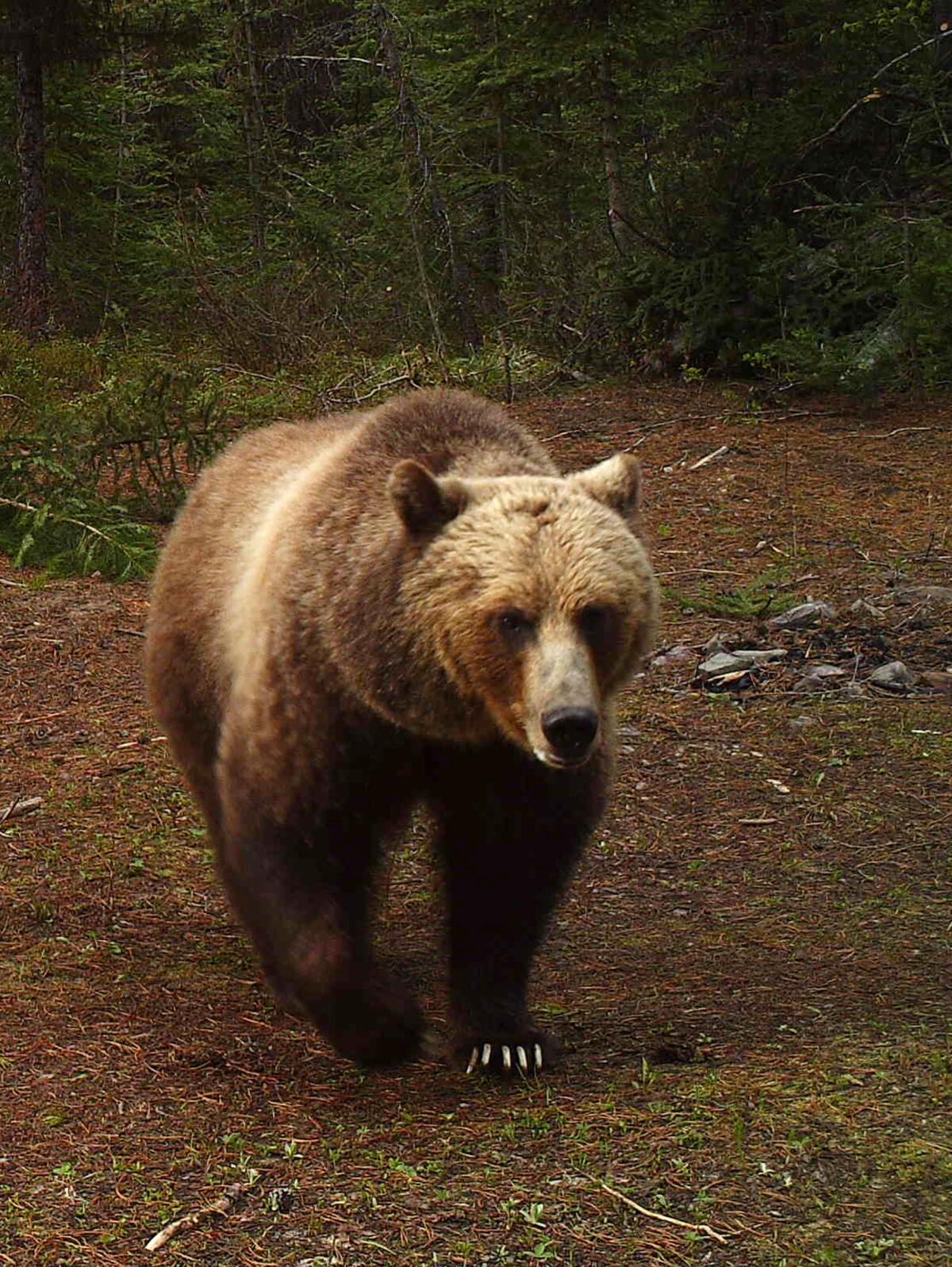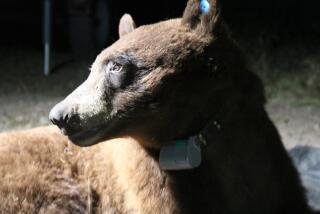Column: Why make the grizzly bear California’s state animal — after they’re all gone?

For thousands of years, grizzly bears roamed California, from the far north to what is now the Mexican border.
Often 8 feet tall when standing, weighing in at a thousand pounds or more, they were golden brown, with a pronounced shoulder hump, and they typically lived for 20 to 30 years. It’s estimated there were 10,000 in the state at the beginning of the 19th century.
To Teddy Roosevelt, the grizzly was a “great shaggy mountain king,” as he wrote in The Times in 1892. To the early California cattle ranchers and sheep farmers, grizzlies were a persistent threat to livestock. To native people, they were often viewed with religious reverence.
Opinion Columnist
Nicholas Goldberg
Nicholas Goldberg served 11 years as editor of the editorial page and is a former editor of the Op-Ed page and Sunday Opinion section.
Above all, the bears were a symbol of wild, untamed nature, which some Californians admired and others sought to conquer.
And conquer they did. Less than 75 years after statehood, the California grizzly, deemed a threat to westward expansion and human settlement, had disappeared — hunted, trapped, poisoned, shot.
The last recorded killing of a wild grizzly in California was in August 1922, probably in Tulare or Fresno county, in the southern Sierra. That was 100 years ago this month.
Happy anniversary.
One more grizzly was sighted a couple of years later near Sequoia National Park before wandering off. That was the last one seen in the state.
Today, grizzlies in the Lower 48 are confined to Idaho, Montana and Wyoming. Their population dropped from 50,000 to about 1,500 before they were declared endangered in 1975. Now there are about 2,000.
Grizzly bears are expanding their range in the northern Rockies, spreading from remote wilderness into farmland as a legal fight plays out over proposed hunting.
In their California heyday, grizzlies — Ursus arctos horribilis — ranged freely through the Santa Monica Mountains and the Sierra Nevada, along the Santa Barbara coast and all through the state. Despite their reputation as ferocious predators, which they certainly could be, they were normally “frugivorous and insectivorous,” as Roosevelt put it in The Times. They scrounged for bugs, berries and fruit. They also ate fish out of the rivers and scavenged whale carcasses on the coast.
And, yes, they were partial to livestock when they could get their paws on it.
To Allen Kelly, who wrote a classic 1903 book on the subject, the grizzly has “a reputation much worse than he deserves, as an excuse for his persecution and a justification to his murderers.”
Before California grizzlies were killed off, the pages of The Times were filled with stories of their ferocity. The paper praised the “single-shot grizzly bear king,” Chester Ellsworth of Long Beach, who had killed 30, each with just one shot from his Winchester 405. There were articles about the savage bear-and-bull fights with which humans amused themselves, and of encounters in the wild. A typical account depicted a “Thrilling Battle with Giant Grizzly,” extolling the “skill, daring and accuracy” required to hunt them. (Grizzlies can run as fast as 35 miles an hour for short distances.)
They were killed, among other places, in the then-wilds of Laurel Canyon and in the Cahuenga Pass near where the Hollywood Bowl is now.
Today, it seems odd and offensive that the bear not only adorns the state flag — California law says it must be “a brown grizzly bear walking toward the left with all four paws on a green grass plot, with head and eye turned slightly toward the observer” — but is also the official state animal. That was approved by the Legislature and the governor in 1953.
Not long ago, the grizzly bear graced more than the state’s flag in California.
In other words, the state elevated the California grizzly to a place of honor just three decades after wiping it out entirely. After tormenting the animals with bull-and-bear fights, lassoing them, caging them, displaying them, hunting and poisoning them, the state gave the grizzly the same position of symbolic distinction it gave to the California redwood, designated the state tree.
Sometimes you have to marvel at the audacity of humans, at the tolerance for irony and cognitive dissonance.
For my part, as I read about the treatment of the grizzly by California’s European settlers, I couldn’t help but remember the way they treated the Native people they encountered.
“It was all part of the same project — a grand dispossession,” said Peter Alagona, a professor of environmental sciences at UC Santa Barbara and founder of the California Grizzly Research Network. “It was made very clear that the land had to be cleared of animals like grizzlies that would threaten businesses and ranches — and also of Indigenous people.”
In 2014, the Center for Biological Diversity called on the U.S. Fish and Wildlife Service to designate new grizzly recovery zones in California and to consider reintroducing the bears into the California ecosystem.
The agency rejected the petition, but a court challenge is ongoing. It would mean bringing in grizzlies from elsewhere, such as Montana, and trying to build a sustainable population here.
Unsurprisingly, it’s a highly controversial idea — bringing back a wild animal that is the subject of such fearsome memories to a state with 39 million people, 10 times the population in 1922.
“Grizzlies are incredibly majestic and inspiring animals,” said Noah Greenwald, the endangered species director at the Center for Biological Diversity. “Reintroducing them would right a historic wrong.”
A bear was spotted in an Eagle Rock neighborhood Tuesday night. The animals typically don’t roam that far south into the city.
Greenwald notes that in many European countries (and in less populated parts of the western U.S.) the bears, or similar ones, live in relatively close contact with people and conflict is very limited.
Still, it strikes me as unlikely to happen, especially at a moment when black bears are already being forced from their habitat by wildfires and are stumbling onto freeways where they’re being killed in record numbers.
But what harm is there in studying what it would take to establish a population, and figure out where the bears could come from and what might be reasonable reintroduction sites?
“Overall, I think people really love bears,” said Alagona. “They’re the closest thing to humans in our part of the world where other primates don’t exist.”
Unfortunately, we have a funny way of showing it.
More to Read
A cure for the common opinion
Get thought-provoking perspectives with our weekly newsletter.
You may occasionally receive promotional content from the Los Angeles Times.












